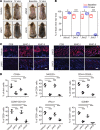Selective inhibition of JAK3 signaling is sufficient to reverse alopecia areata
- PMID: 33830087
- PMCID: PMC8119218
- DOI: 10.1172/jci.insight.142205
Selective inhibition of JAK3 signaling is sufficient to reverse alopecia areata
Abstract
The Janus kinase/signal transducers and activators of transcription (JAK/STAT) are key intracellular mediators in the signal transduction of many cytokines and growth factors. Common γ chain cytokines and interferon-γ that use the JAK/STAT pathway to induce biological responses have been implicated in the pathogenesis of alopecia areata (AA), a T cell-mediated autoimmune disease of the hair follicle. We previously showed that therapeutic targeting of JAK/STAT pathways using the first-generation JAK1/2 inhibitor, ruxolitinib, and the pan-JAK inhibitor, tofacitinib, was highly effective in the treatment of human AA, as well as prevention and reversal of AA in the C3H/HeJ mouse model. To better define the role of individual JAKs in the pathogenesis of AA, in this study, we tested and compared the efficacy of several next-generation JAK-selective inhibitors in the C3H/HeJ mouse model of AA, using both systemic and topical delivery. We found that JAK1-selective inhibitors as well as JAK3-selective inhibitors robustly induced hair regrowth and decreased AA-associated inflammation, whereas several JAK2-selective inhibitors failed to restore hair growth in treated C3H/HeJ mice with AA. Unlike JAK1, which is broadly expressed in many tissues, JAK3 expression is largely restricted to hematopoietic cells. Our study demonstrates inhibiting JAK3 signaling is sufficient to prevent and reverse disease in the preclinical model of AA.
Keywords: Autoimmunity; Inflammation; Skin; T cells.
Conflict of interest statement
Figures





Similar articles
-
CS12192 Reverses Alopecia Areata by Selectively Targeting JAK3/JAK1/TBK1.Adv Biol (Weinh). 2025 Aug;9(8):e2400769. doi: 10.1002/adbi.202400769. Epub 2025 Feb 28. Adv Biol (Weinh). 2025. PMID: 40021475
-
Induction of T cell exhaustion by JAK1/3 inhibition in the treatment of alopecia areata.Front Immunol. 2022 Sep 20;13:955038. doi: 10.3389/fimmu.2022.955038. eCollection 2022. Front Immunol. 2022. PMID: 36203601 Free PMC article.
-
Combined anti-fibrotic and anti-inflammatory properties of JAK-inhibitors on macrophages in vitro and in vivo: Perspectives for scleroderma-associated interstitial lung disease.Biochem Pharmacol. 2020 Aug;178:114103. doi: 10.1016/j.bcp.2020.114103. Epub 2020 Jun 17. Biochem Pharmacol. 2020. PMID: 32562787
-
Role of janus kinase inhibitors in the treatment of alopecia areata.Drug Des Devel Ther. 2018 Jul 27;12:2323-2335. doi: 10.2147/DDDT.S172638. eCollection 2018. Drug Des Devel Ther. 2018. PMID: 30100707 Free PMC article. Review.
-
Janus kinase inhibitors: An innovative treatment for alopecia areata.J Dermatol. 2019 Aug;46(8):724-730. doi: 10.1111/1346-8138.14986. Epub 2019 Jun 25. J Dermatol. 2019. PMID: 31237712 Review.
Cited by
-
Alternative splicing of CARM1 regulated by LincGET-guided paraspeckles biases the first cell fate in mammalian early embryos.Nat Struct Mol Biol. 2024 Sep;31(9):1341-1354. doi: 10.1038/s41594-024-01292-9. Epub 2024 Apr 24. Nat Struct Mol Biol. 2024. PMID: 38658621 Free PMC article.
-
Markers of Venous Thromboembolism Risk in Patients with Alopecia Areata: Is There Anything to Worry about?Dermatol Ther (Heidelb). 2023 Aug;13(8):1847-1855. doi: 10.1007/s13555-023-00971-7. Epub 2023 Jul 9. Dermatol Ther (Heidelb). 2023. PMID: 37423962 Free PMC article.
-
Recent Advances in Drug Development for Hair Loss.Int J Mol Sci. 2025 Apr 8;26(8):3461. doi: 10.3390/ijms26083461. Int J Mol Sci. 2025. PMID: 40331976 Free PMC article. Review.
-
The efficacy and safety of JAK inhibitors for alopecia areata: A systematic review and meta-analysis of prospective studies.Front Pharmacol. 2022 Aug 24;13:950450. doi: 10.3389/fphar.2022.950450. eCollection 2022. Front Pharmacol. 2022. PMID: 36091777 Free PMC article.
-
The Involvement of RIPK1 in Alopecia Areata.Int J Mol Sci. 2025 Feb 13;26(4):1565. doi: 10.3390/ijms26041565. Int J Mol Sci. 2025. PMID: 40004031 Free PMC article.
References
Publication types
MeSH terms
Substances
Grants and funding
LinkOut - more resources
Full Text Sources
Other Literature Sources
Molecular Biology Databases
Research Materials
Miscellaneous

